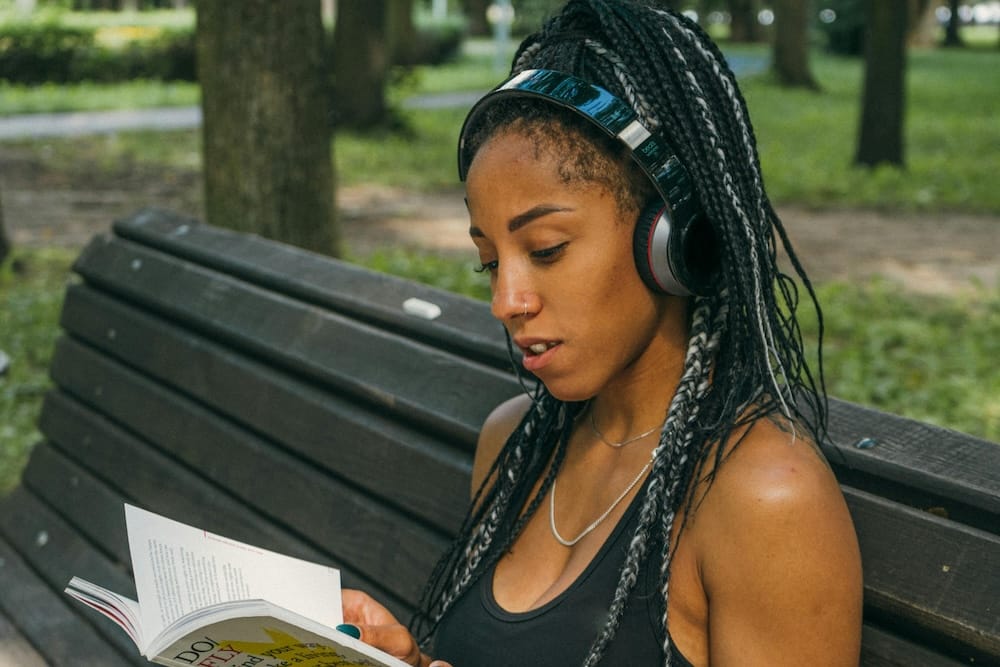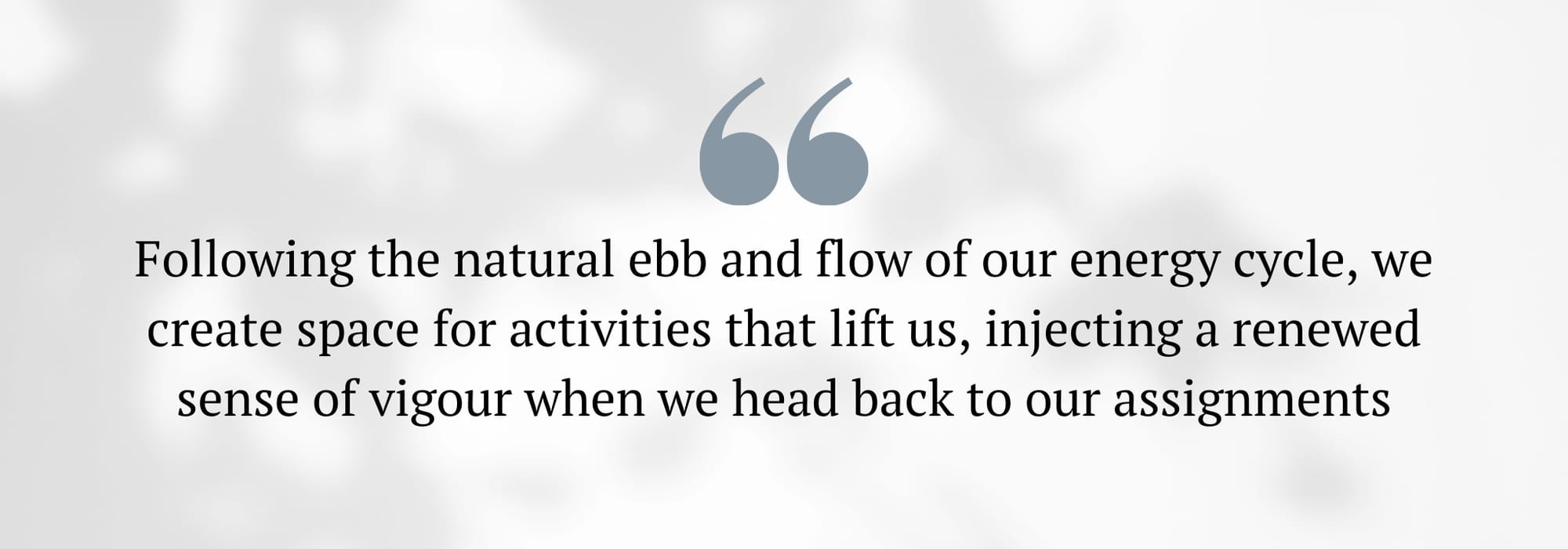Could a purposeful pause be the key to productivity?
updated on Jun 14, 2024

Here's how to make the most of microbreaks
The proof of a productive day is often linked to packing in as many hours as possible. Waking up earlier, powering through lunch, back-to-back meetings, taking calls when we’re off – these actions have been normalised into contemporary working life, tipping into our down time in the name of achieving more.
On the face of it, it makes sense. Working more = greater productivity. Greater productivity = a better reputation at work. A better reputation = a chance of getting ahead. But we have to ask ourselves: what is this high-octane work culture doing to our wellbeing? Are we really getting more done? Or is there a more balanced and sustainable approach that fosters productivity, creativity, and advancement at work, with big wellness wins, too?
A pause for productivity
The popular narrative might be to hustle hard 24/7, but planning pauses in your day is highly unlikely to hinder output. In fact, studies suggest it can actually boost it and enhance productivity and reduce stress.
It’s all thought to come down to our ‘ultradian rhythm’: a series of 90-minute, recurrent biological cycles that our bodies follow throughout the day. We’re in the high focus zone during the first 90 minutes, but as the cycle progresses, focus wanes and productivity suffers.
Pausing is a way to renew that focus and refresh the skills we need to thrive at work – like solving problems, being creative, and making confident decisions. By purposefully stepping away from the task at hand, and following the natural ebb and flow of our energy cycle, we create space for activities that lift us, injecting a renewed sense of vigour when we head back to our assignments.
Indeed, a simple cup of tea and a book might be just the ticket for a mid-morning boost. But what if you were to try other things that provide a deeper sense of self, nurture creativity, and present an opportunity to grow physically, emotionally, and spiritually?

An ikigai approach
Personal and professional development coach Helen Robinson says: “Having purposeful breaks can encompass two distinct meanings: firstly, intending to take a break, and secondly, deriving value from that break.”
Where you find that value exactly will likely come down to personal preference and interests, but the Japanese custom of ikigai can be a useful place to start.
“Ikigai offers a unique perspective on how we can maximise work breaks to enhance wellbeing and positivity,” says Helen. “The most concise translation of ikigai is finding value in daily living. It embodies a sense of purpose, meaning, and joy in our existence. It’s about consciously living in alignment with one’s purpose, which fosters meaning and contentment.”
It certainly stacks up that people who are tuned into ikigai tend to be more content and motivated. And it’s believed to be linked to lower levels of depression and higher self-esteem too, influencing all areas of life, including work, with one study published in the International Journal of Mental Health and Addiction finding that participants who engaged with ikigai had a high predictability of strong mental wellbeing, alongside low scores on measures of depression.
Purposeful pauses versus procrastination
Most of us will be familiar with work procrastination via those nagging, un-ticked tasks that sit unnervingly in the back of our minds. And yet, the more we dread a task, the more we find ways to put it off. You might think that your current habit of social media scrolling could count as a break, but the reality is that procrastination activities such as this can overload our prefrontal cortex, and don’t leave us with that sense of accomplishment, or rejuvenation we need from a purposeful pause. In fact, a 2018 study, published in the Journal of Social and Clinical Psychology, found a causal link between excessive social media use and increased feelings of depression and loneliness.
This intention behind how you spend your time is the key difference between microbreaks and procrastination – the former being a way to recharge your energy supplies, and stimulate yourself with fulfilling or rewarding activities, while the latter is an avoidance technique, that most likely leaves you feeling more drained and stressed as it seems like you’ve not made progress, or replenished yourself at all.
Rather than mindlessly reaching for your phone throughout the day, microbreaks bring routine to the fore, and help us lean towards productivity in a healthy, balanced way. Think about activities you want to do that encourage creativity, movement, or a connection. These types of breaks shift us away from procrastination and help to improve motivation.

3 ways to make the most of microbreaks
1. Build your break bank.
From finding your ikigai, to recognising what self-care practices refill your cup, create a bank of activities to stimulate your senses while taking a purposeful pause. We all have a unique set of emotional and physical needs; if you’re an active person, a break might be a 30-minute power walk. For creative blocks, colour, music, or nature might be just the salve to spark new ideas. By having a range of options, and assessing what we need from breaks, we can effectively pull from the break bank to best support ourselves. And, what you’ll often find is that the culmination of these microbreaks over the course of the day leaves you feeling far more fulfilled by the end of it. When you’re more intentional with your time, you’ll feel less emotionally drained, have a greater sense of achievement, and find that balance of ticking off the work to-do list, while also honouring your own wants and needs.
2. Grow awareness of your ultradian rhythm.
Whether it’s 60 seconds of nature gazing or 30 minutes of ikigai, every break that shifts your perspective is a wellness win. And while common time management tools like the Pomodoro technique (25-minute stretches of work broken up by five-minute breaks) can help set a healthy routine, the timing of your breaks – and how long you break for – is best led by your innate understanding of your ultradian rhythm and what you need in that moment.
While the typical energy cycle is believed to be about 90 minutes, it’s worth developing a stronger awareness of how your personal energy and attention fluctuates. You might want to use a digital tracker, or simply a notebook, to record the times throughout your typical day when you’re flagging, and experiment with what microbreak serves you best at these various moments. For example, disengaging from work only for a few minutes, but on a regular basis, can be all you need for a sufficient break in the morning. Mental fatigue tends to set in more in the afternoon, so scheduling longer breaks can be beneficial at that point.
3. Recognise procrastination.
And tackle it head on by planning purposeful breaks that give you a renewed sense of focus. By injecting activities into your day that serve you on a self-care level, you can refrain from falling into the negative spiral of procrastination that can trigger things like poor decision-making and avoiding tasks. Microbreaks have the ability to shift you into the realm of ‘doing’ rather than ‘avoiding’, and are a great way to retrain the mind.
You can approach this in two ways: when creating your to-do list, plan in microbreaks and what activities you intend to do in that time; or when you notice yourself procrastinating, take it as a sign you need a purposeful pause, and instead refer back to your break bank to choose something that serves your wellbeing better.
Enabling productive pauses can be hugely empowering – unlocking a new sense of self-awareness that can help us truly flourish in life and work. So, next time you feel guilty for having a breather, remember: taking a break can be pretty productive after all.

